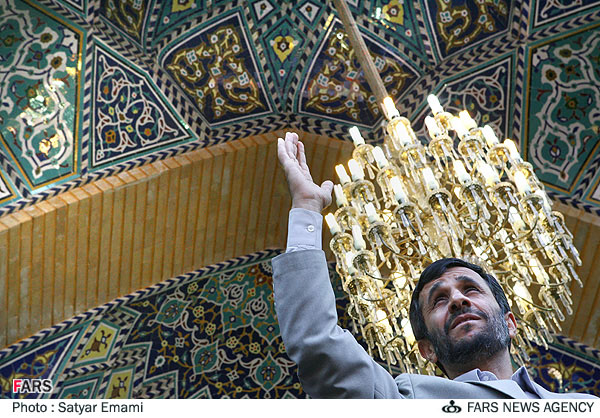A breakdown of Ahmadinejad's cultural budget
by REIHANEH MAZAHERI in Paris
08 Apr 2010 22:08No Comments
 Budget funds earmarked for culture largely spent on institutions that back the president.
Budget funds earmarked for culture largely spent on institutions that back the president.
[ analysis ] The administration of President Mahmoud Ahmadinejad is using state funds to spread its political and religious ideology and at the same time trying to maintain powerful allies during times of turmoil, critics say.
The authorities have set aside USD $4.5 billion of the $347 billion 2010-11 budget, which took effect on March 21, for cultural matters. But much of it is spent on religious and culturally hardline institutions sympathetic to the administration.
Ever since first becoming president in 2005, Ahmadinejad has made a clear effort to defend religious groups and organizations to a degree previously unknown in the country.
He set out his thinking in a speech to clergy in southern Fars province in 2007, saying, "In the budget of previous administrations, no room was found for religious centers and religious matters. However, we have taken them into consideration in the budget."
The budget for "mosque centers," one of the government's main sources of popular support, has increased to $25 million from $1.6 million in 2005 at the end of the term of reformist president Mohammad Khatami, according to Mohammad Hosseini, the Minister of Culture and Islamic Guidance.
These centers are known to be bases for the Basij militia, who use them as platforms from which to advance the government's political and religious agenda.
There are no exact figures for the number of mosque centers in Iran, but according to an economist residing in Tehran, the government built 6,000 of them across the country between 2005 and 2008. By contrast, he said, the Khatami administration from 1997 to 2005 used a large chunk of the national budget to encourage cultural matters such as printing more books.
The number of titles published in 2005 was around 52,000 but this fell to about 45,000 in 2008.
The same economist said, "The government benefited from the support of religious institutions such as mosque centers during its crackdown after the June 12 presidential election."
Ahmadinejad began his financial support of religious institutions while he was mayor of Tehran, before becoming president. According to Mohammad Hossein Saffar-Harandi, former Minister of Culture and Islamic Guidance, in the year before he came to power in 2005, Ahmadinejad gave $1.1 million toward religious organizations.
Another institution that has benefited from government assistance in recent years is the Showraye Aliy-e Howze Elmieh Qom, the High Council of Qom Seminary, which is in charge of managing and controlling the Iranian clergy's main city.
At the end of his presidential term, Khatami handed Ahmadinejad a $23 million budget for this organization. However, it has increased to 180 million in the past four years.
Another example is the budget for the gigantic Sazeman-e Tablighat-e Eslami, the Islamic Propaganda Organization. This functions under the supervision of Supreme Leader Ayatollah Ali Khamenei and one of its responsibilities is to orchestrate pro-government demonstrations.
It was this organization that brought pro-government forces onto the streets of Tehran on December 30, three days after the opposition's protest on the feast of Ashura.
Its budget is thought to run to hundreds of millions of dollars and appears to be increasing since the Khatami era.
Other funds, both large and small, are allocated each year for the purpose of advancing religious culture, but the details are murky.
For example, the budget item "support for religious teachings, culture, and arts" was around $2 million in 2006 but went up to 15 million in 2007.
The budget item "advancement plan for mosque cultural activities" also witnessed a fourfold increase during the same period from $4 million to $17 million.
Similarly, the $9 million budget for "support and direction of cultural and religious activities" was quadrupled to $32 million.
In one of the budget tiers for 2010, around $90 million has been put aside solely for religious centers such as Setad-e Amr be Marouf va Ney az Monkar. This governmental institution involves itself in all public, and at times private, spheres of life in order to ensure compliance with Islamic principles. According to the official Islamic Republic News Agency, IRNA, its funding has increased by 28 percent since last year.
The government also has a capital acquisition budget to help nongovernmental organizations purchase property. Two thirds of this budget of roughly $42 million, which constitutes a 300 percent increase since last year, is in the hands of pro-government religious centers.
For example, $10 million has been allocated to the Imam Khomeini Educational and Research Institute which belongs to Ayatollah Mesbah Yazdi. In a speech during post-election protests, this hardline cleric, who supports Ahmadinejad, equated obedience to the president with obedience to God.
The Ayandeh Roshan Institute will also get $1.2 million from this budget. This organization advances government messianic and apocalyptic ideology. It was founded with the help of Ahmadinejad while he was mayor of Tehran.
Esfandiar Rahim Mashaei, a close friend and Ahmadinejad's chief of staff, was at one point on its board of directors.
In addition, the Ahmadinejad administration originally intended to control three percent of the income of public firms of around $11 billion in the 2010-11 national budget under the pretext of assisting cultural, social, and sports affairs.
This money was supposed to be spent under the supervision of Rahim Mashaei, who also heads the government's cultural commission. However, parliamentary members concerned about the lack of transparency in how this money would be spent did not approve the plan.
These are the more overt examples of government favoritism toward its friends and supporters. In reality, it is unclear how all the general line items of the official budget are actually spent. This lack of transparency raised criticism from many members of parliament but they ultimately had no choice but to back down mostly because time to discuss the issues ran out.
Ali Mottahari, a member of the Majlis Cultural Commission, told the Mehr news agency, "The different tiers of the budget greatly strengthen the government's hand in how it wants to spend the money and at the same time limit the supervisory control of the Majlis. When there's a general line item, the Majlis cannot question the [government's way of] spending it."
An expert in religious matters, who preferred not to be named, believes that the government has been successful in the allocation of large sums for the organization of a strong minority of supporters but that it has not actually had much effect.
"All this money has not really had an impact on cultural trends and attitudes of the majority of the population in the direction favored by the government," he said.
This article first appeared on the Mianeh website.






























No Comments